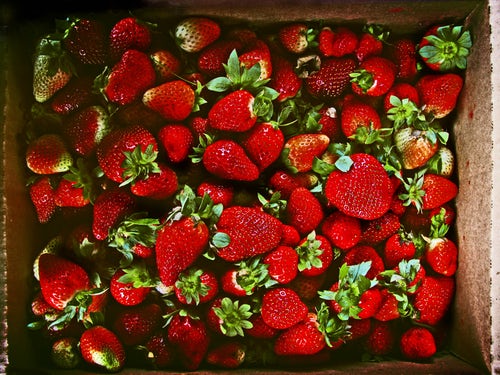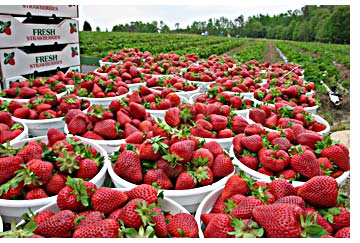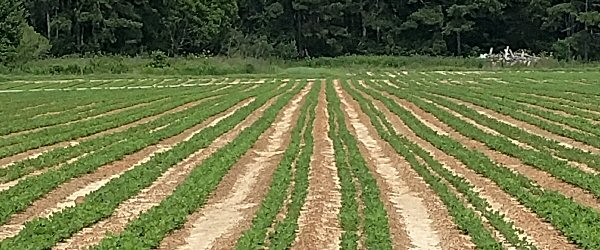While specialty crop producers account for close to half the crop value in the U.S., few participate in or benefit from these programs. In fact, few growers are even aware of existing NRCS programs that could benefit them, such as the Environmental Quality Incentives Program (EQIP). In a survey of strawberry growers at the 2005 Southeast Strawberry Expo, 91 % were unaware that EQIP could offer them financial assistance and 79% did not know how to apply. Only 12 % had applied for EQIP contacts, mostly for practices on other crops. A survey at the 2006 Southeast Strawberry Expo yielded similar results. To find out more about strawberry growers' current conservation practices and get their ideas about what practices and programs might benefit them, CAP and NCSA staff visited strawberry growers on their farms, targeting east-of-Raleigh counties in the Neuse River basin. Like the other growers surveyed, these growers had not considered or applied for EQIP programs. All used some traditional conservation practices already, such as planting ryegrass between their plastic-covered strawberry beds to prevent erosion and rotating the crops on their other acreage. They were interested in doing more and intrigued that pest management practices would be considered conservation. However, as one grower said, "We want to be on the cutting edge in conservation or pest management, but it is hard to experiment at your own expense." The project then met with NC State University extension specialists to identify practices that would be the "best fit" for EQIP – ones that would address conservation concerns regarding soil, air, and water quality, would interest and benefit growers, and would be administratively manageable for NRCS staff. Several practices of particular interest centered around replacements for methyl bromide, currently used as a soil fumigant by almost all strawberry growers in the Southeast. Because it is an ozone depleter, methyl bromide (MB) is in the process of an internationally mandated phase-out under the Montreal Protocol, but growers have been reluctant to try alternatives. Another area of opportunity was the use of row covers to conserve water resources and mitigate erosion concerns. Strawberry growers generally use overhead irrigation for frost protection in late winter and early spring, applying as much as 2700 gallons/hour per acre, or 1 acre-inch per night, often for several nights in a row. All this water leaches out fertilizers and pesticides and causes erosion. Spun-bonded row covers are costly, but reduce or eliminate the need for this overhead irrigation. Unfamiliarity and inexperience present a major challenge in getting specialty crop farmers such as strawberry growers connected with conservation programs like EQIP. Growers don't know what's available and how to apply to the programs, and conservationists don't know much about the crops and their production practices. To help inform growers, CAP director Larry Elworth led a session for growers on conservation programs at the November 2006 Southeast Strawberry Expo. A short article about the new cost share programs was published in the December Strawberry Grower newsletter, and some Extension agents also shared the news with their growers. Growers from ten farms attended a meeting in mid-December to learn more, and several others expressed interest. NRCS sent information out to all North Carolina district offices informing them about the practices that had been newly approved for cost-share. Since the first deadline for applications to be considered for 2007 was January 19, there was scant time to ready an application to EQIP, but a number of growers have applied. Others are taking the time to create a more complete application package in consultation with a conservationist, or are waiting to see how the process plays out for those who did apply. In general, growers have been especially interested in the row cover cost share, since the financial return is substantial and they easily recognize many other benefits to row covers besides conservation. These include reduced risk to their crop, the flexibility to rotate crops into fields where large quantities of water are not available, and a good night's sleep instead of staying up all night to irrigate in freezing conditions. They are also quite interested in the VIF option, and less so the MB alternatives cost share—although deadlines for MB availability loom, the payment alone is not enough incentive to break from familiar practices and materials. Since many strawberry growers may already feel that conservation programs are only for row crops and livestock or for "the same old group of big farmers" and the whole process is opaque and unfamiliar to them, there is still a large task ahead to educate both sides of the conservation table. One of this project's goals is that the initial application or inquiry will be followed up by a conservationist's visit to the farm, discussion of other practices the farm might benefit from, and the development of a complete conservation plan that benefits both grower and environment. Other possible conservation practices for strawberries are already being discussed, such as a cost share for compost use to improve soil quality and reduce fertilizer leaching, and additional ideas for workable programs will emerge as growers and conservationists begin to work together and understand each other. The growers who have applied in this first year of the program are indeed pioneers in new territory. North Carolina strawberry farmers may become pioneers in increasing participation by specialty crop producers in the federal conservation programs administered by the Natural Resources Conservation Service (NRCS). The Center for Agricultural Partnerships (CAP) and the North Carolina Strawberry Association (NCSA), with technical assistance from NC State University extension specialists and the support of the state NRCS office, are working to increase awareness of these programs among growers and develop programs targeted towards their specific needs and production practices.
North Carolina strawberry farmers may become pioneers in increasing participation by specialty crop producers in the federal conservation programs administered by the Natural Resources Conservation Service (NRCS). The Center for Agricultural Partnerships (CAP) and the North Carolina Strawberry Association (NCSA), with technical assistance from NC State University extension specialists and the support of the state NRCS office, are working to increase awareness of these programs among growers and develop programs targeted towards their specific needs and production practices. Proposals for new cost shares specifically for strawberries were then presented to NRCS, along with related proposals for vegetables and sweetpotatoes. In November 2006 they were approved for 2007 as "595 Pest Management" practices. "Row Cover – Mulching for strawberry crop systems" will pay growers $700 per acre for row covers (half of an estimated cost of $1400/acre to buy the covers and labor to apply them) for up to a maximum of ten acres. "IPM-Reduced-risk Alternative Fumigants to Methyl Bromide" encourages growers to try alternatives, paying $50/acre, half the additional cost for currently available alternative products. And "Virtually Impermeable Film (VIF) Tarping" pays half the cost of this relatively new –and more expensive-- bedding plastic, which reduces gas flow of fumigants to the atmosphere so they can be applied at much lower rates. Growers can use the VIF either with their current methyl bromide/chloropicrin fumigation or with an MB alternative. The cost share to the participant is $90/acre for use of the VIF tarping.
Proposals for new cost shares specifically for strawberries were then presented to NRCS, along with related proposals for vegetables and sweetpotatoes. In November 2006 they were approved for 2007 as "595 Pest Management" practices. "Row Cover – Mulching for strawberry crop systems" will pay growers $700 per acre for row covers (half of an estimated cost of $1400/acre to buy the covers and labor to apply them) for up to a maximum of ten acres. "IPM-Reduced-risk Alternative Fumigants to Methyl Bromide" encourages growers to try alternatives, paying $50/acre, half the additional cost for currently available alternative products. And "Virtually Impermeable Film (VIF) Tarping" pays half the cost of this relatively new –and more expensive-- bedding plastic, which reduces gas flow of fumigants to the atmosphere so they can be applied at much lower rates. Growers can use the VIF either with their current methyl bromide/chloropicrin fumigation or with an MB alternative. The cost share to the participant is $90/acre for use of the VIF tarping. Those growers who have applied report varied experiences at their county NRCS offices. Some have received encouraging and helpful responses to their applications and inquiries. Others have found that conservation staff were unfamiliar with the new programs or were told that the new practices had not yet been approved or that all funds were already committed to other crop or livestock areas. Growers have learned that applications are evaluated based on a ranking system and are concerned that their applications for a few number of practices and small acreage may not rank highly.
Those growers who have applied report varied experiences at their county NRCS offices. Some have received encouraging and helpful responses to their applications and inquiries. Others have found that conservation staff were unfamiliar with the new programs or were told that the new practices had not yet been approved or that all funds were already committed to other crop or livestock areas. Growers have learned that applications are evaluated based on a ranking system and are concerned that their applications for a few number of practices and small acreage may not rank highly.
Putting the Farm Bill to Work Quick Links
- Appalachian Region
- California
- Georgia
- Michigan
- North Carolina
- North Carolina Apple Growers
- North Carolina Nursery Crops
- North Carolina Christmas Trees
- North Carolina Strawberry Growers
- North Carolina Strawberry Survey
- North Carolina Sweetpotato Producers
- North Carolina Sweetpotato Survey Summary
- Western North Carolina Vegetable Growers
- Oregon

